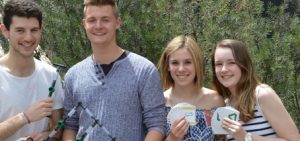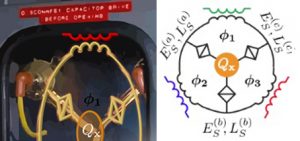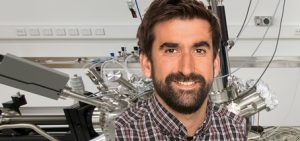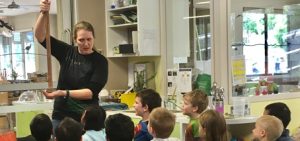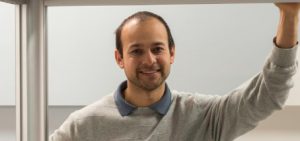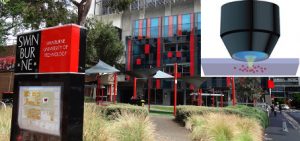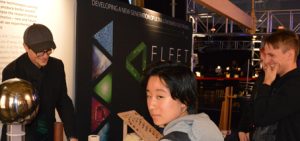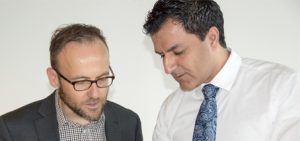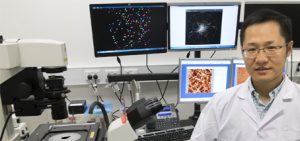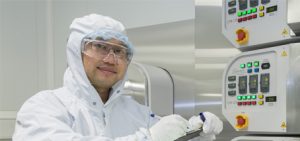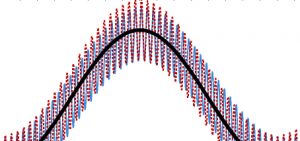Engage
See news from around FLEET, below
Catch up on all past issues of FLEET News newsletter
FLEET News
Fresh minds develop hands-on learning methods for schools FLEET is developing innovative ways to communicate physics to school students. A collaboration with Monash University Science allowed the Centre to enlist fresh brains to this communications challenge. A team of maths and physics students from Monash Bachelor of Science–Global Challenges took on the task of developing hands-on games and resources to demonstrate …
In the popular movie franchise “Back to the Future”, an eccentric scientist creates a time machine that runs on a flux capacitor. Now a group of actual physicists from Australia and Switzerland have proposed a device which uses the quantum tunneling of magnetic flux around a capacitor, breaking time-reversal symmetry. The research, published this week in Physical Review Letters, proposes …
FLEET Chief Investigator Agustin Schiffrin spoke on science show Einstein a Go-Go about experimental physics at the atomic scale, and the study of exciting new nanomaterials with tailored electronic properties. Listen Agustin researches new nanomaterials with novel and exotic electronic properties, constructed of organic (carbon-based) molecules, sometimes inspired by bio-organisms. The team studies topological materials, which display a range of fascinating, …
FLEET shares the responsibility to support students and teachers to increase participation in science, and in particular works towards increasing the number of girls and women participating in physics, chemistry and engineering. The Centre Launch on 12 June will showcase FLEET’s science outreach programs, educating the public and inspiring a new generation of scientists. Home Science and FLEET Geeks programs …
FLEET postdoc Dr Carlos Kuhn described his field of ultra-cold atomic science and the fundamental discoveries made in an interview with RRR science show Einstein a Go-Go. The research will take a huge step forward this year with the commissioning of a new ARC-funded quantum-gas microscope, which will bridge the microscopic (atomic) and macroscopic (visible) worlds. Carlos also described his …
The unusual electronic and magnetic properties of van der Waals (vdW) materials, made up of many ‘stacked’ 2D layers, offer potential for future electronics, including spintronics. In a recent study, FLEET researchers at RMIT found that one promising candidate material, Fe3GeTe2 (FGT), fits the bill – provided it’s created in layers only 200 millionths of a millimetre in thickness. This …
Bridge between microscopic and macroscopic behaviour A new quantum-gas microscope facility at Swinburne University of Technology will allow studies of ultra-cold atomic gases, giving researchers the ability to image and manipulate single atoms. The facility will allow study of quantum effects at a macroscopic scale: a major unsolved issue in physics. To harness the full potential of such quantum materials, …
FLEET PhD student Rebecca Orrell-Trigg (RMIT) uses liquid metals to synthesise 2D (atomically thin) materials for use in future ultra-low energy electronic devices. Late last year they developed a liquid metal “bubbling” method that was described as “ground breaking”, and have since refined this method to make it even more widely applicable. Rebecca’s interview covered the advantages of the new …
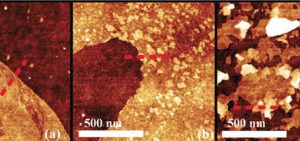
Last year, FLEET researchers at RMIT developed a ground-breaking new method of depositing atomically-thin (two-dimensional) crystals using molten metals, described as a ‘once-in-a-decade’ advance. Earlier this year, the same research team expanded the new method from controlled to ambient conditions, and has properly characterised the growth mechanisms for key tin oxides, which should allow improved control of target oxide growth. …
Melbourne Knowledge Week (May 2018) was an opportunity for FLEET to engage with the public and road-test a number of outreach demonstrations being developed for schools. It also gave 20 Centre members the opportunity to gain valuable experience in public science outreach, speaking to a diverse audience. Melbourne Knowledge Week showcases cool science and engineering projects in the city of …
An MP visit last week provided an opportunity to discuss future electronics, 2D materials and science policy. Melbourne MP and Greens Science/Energy spokesperson Adam Bandt was visiting FLEET’s labs at RMIT, hosted by FLEET RMIT node leader Kourosh Kalantar-Zadeh, and FLEET Director Michael Fuhrer. As well as FLEET researchers, Adam also got to meet our scientific counterparts from the Centre for …
FLEET-nano collaboration recognised: Congratulations to Qiaoliang Bao, 2018 ANFF-VIC Technology Fellow Qiaoliang Bao works at the nanoscale, trapping photons in atomically-thin, two-dimensional materials, where high binding energies create a quantum state known as a superfluid. The aim is a new generation of superfluid transistors that will ‘switch’ using much less energy than conventional electronics. Such work requires access to the …
“Endless” possibilities for custom nanotech design FLEET’s research to achieve zero-dissipation electrical current depends on the design of key nanoscale structures. Within FLEET, nano-device fabrication is coordinated via Enabling technology B, which links each of the research themes. In 2017, Theme B leader Lan Wang, and PhD student Cheng Tan, developed a method to build such nanoscale structures, required to achieve zero-dissipation …
“It’s so simple my retired parents could do this in their kitchen.” FLEET AI Torben Daeneke discussed deceptively-simple methods of depositing atomically-thin materials with Rohan Neagle, on Radio Adelaide’s Subatomic radio show. Torben’s interview also covered why 2D materials are key to ultra-low energy electronics, the mechanics of 2D deposition, the end of Moore’s Law and the massive amount of …
Recent theoretical studies at Monash University bring us a step closer to realistic ‘quantum batteries’. Such technology would depend on the energy difference offered by different quantum states, rather than on electrochemical changes, as is the case in traditional batteries. Quantum batteries also offer potential for vastly better thermodynamic efficiency, and ultra-fast charging time. The study, which was co-led by …

